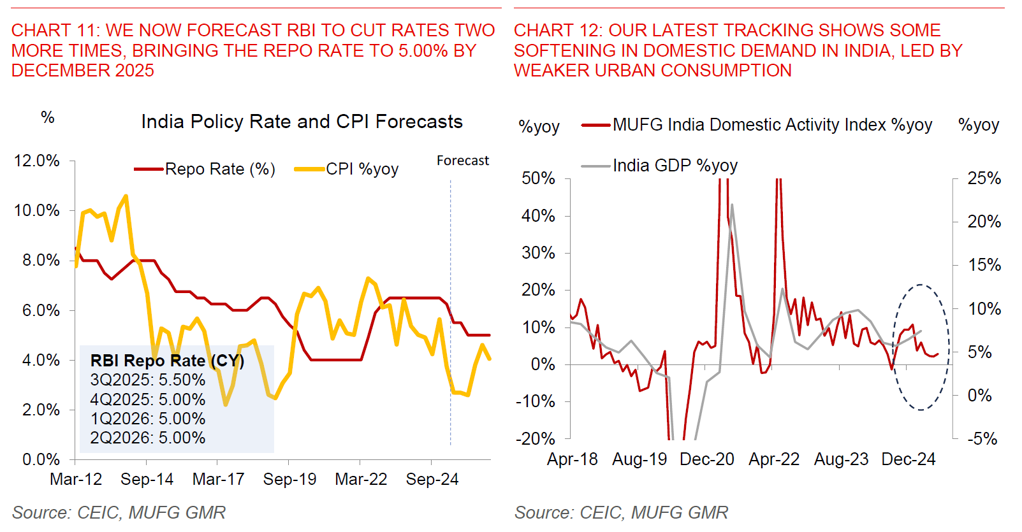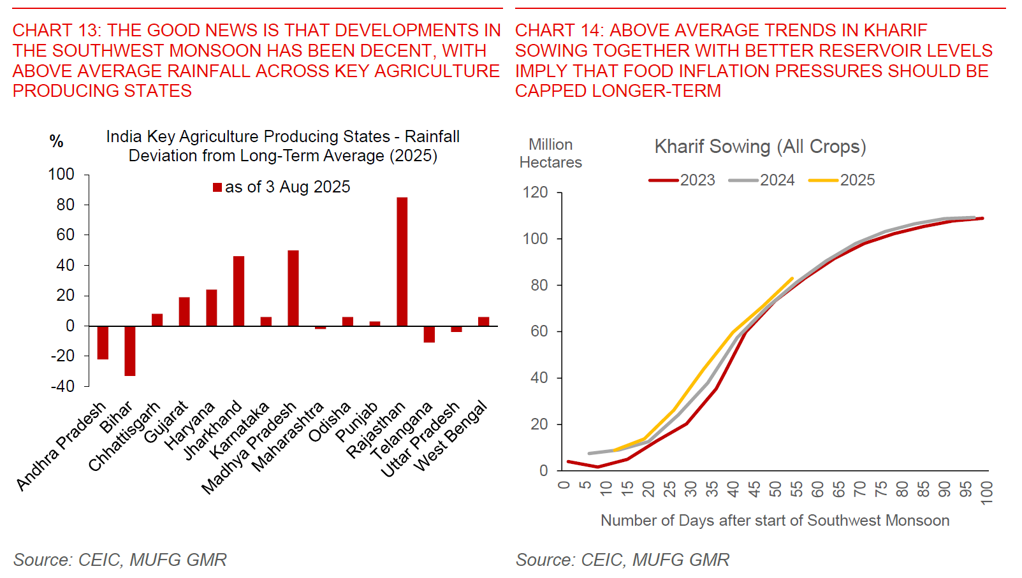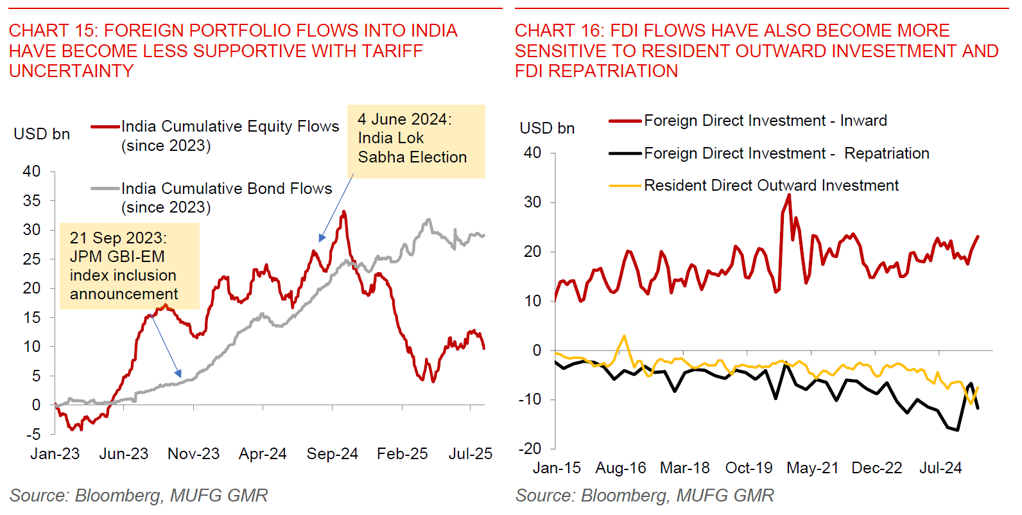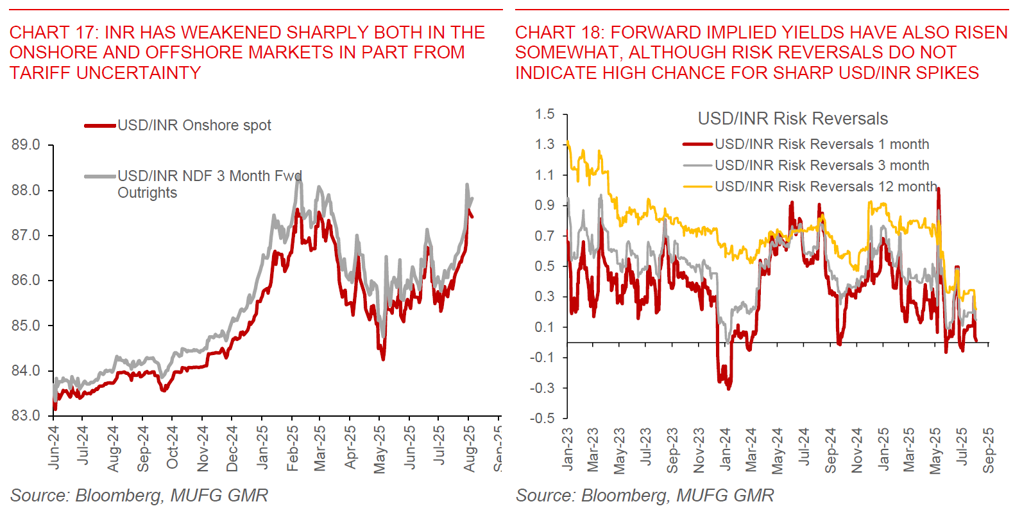- We have shifted our INR forecast profile weaker, and we now expect USD/INR at 87.00 by December 2025 and 86.50 by March 2026. While we continue to see USD/INR trending lower over time given our global team’s expectations of a weaker Dollar, our numbers imply a shallower profile relative to our previous forecasts, and as such also some INR underperformance against Asian currencies and core G10 such as EUR and JPY.
- Key to our forecast change is that the reciprocal tariff rate of 25% for India was a downside surprise relative to our previous assumption that India strikes a trade deal with the US with tariffs below 20%. In addition, several other countries which compete directly with India across a range of sectors also received lower tariff rates, and so competitive advantage for India’s export sector could be eroded to some extent if these proposed tariff rates stick. While our best sense right now is that there will likely still be a trade deal, the chance for India to get a much better rate relative to its export competitors is now much lower. These coupled with left tail risks of Russia secondary sanctions should argue for a softer INR profile relative to our previous expectations.
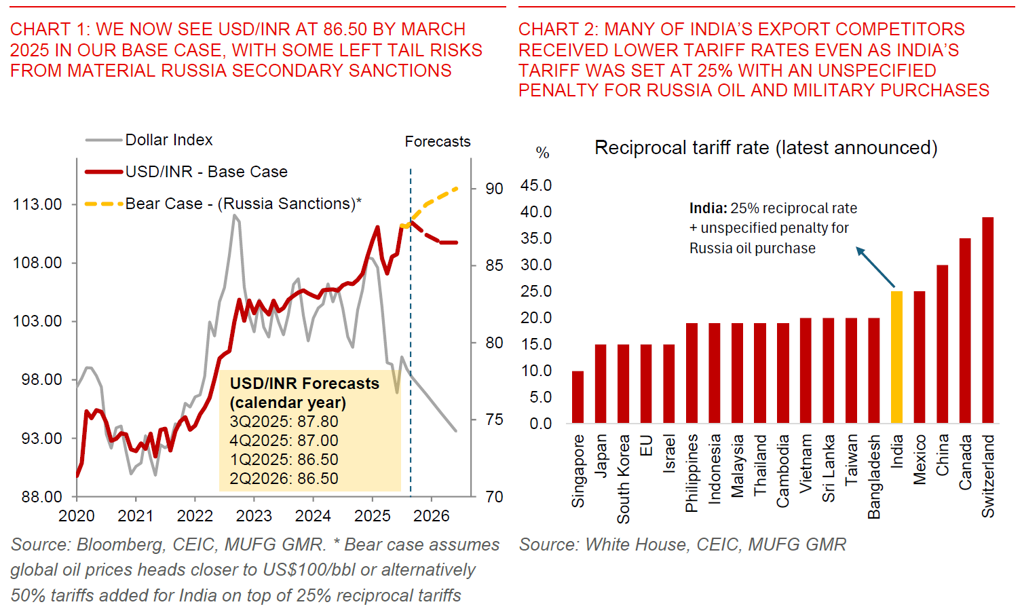
- We see INR potentially weakening further if threats on Russia secondary sanctions play out. We do not assume either material Russia secondary sanctions and/or a sharp spike in oil prices, although we build in some gradual removal of the Russia oil discount in India’s trade deficit. Nonetheless, we think risks to our forecasts are balanced, given alternative scenarios of an eventual resolution in the Russia-Ukraine war, coupled with still ample global oil supplies.
- We also now forecast RBI to cut rates two more times, bringing the repo rate to 5.00% from 5.50% currently. This compares with our previous forecast of one more cut. We see these two cuts likely coming in the October and December meetings, and for the RBI to keep rates on hold thereafter till 2H2026. Domestic positives such as low inflation, a decent Southwest Monsoon, coupled with supportive monetary and fiscal policy are likely to remain key local drivers.
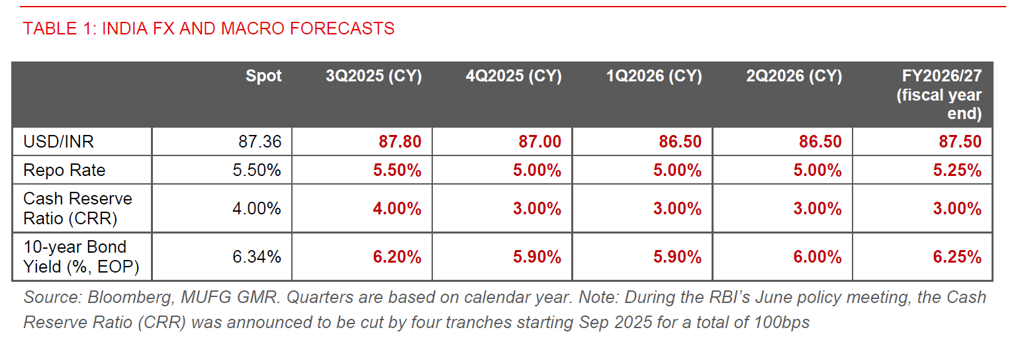
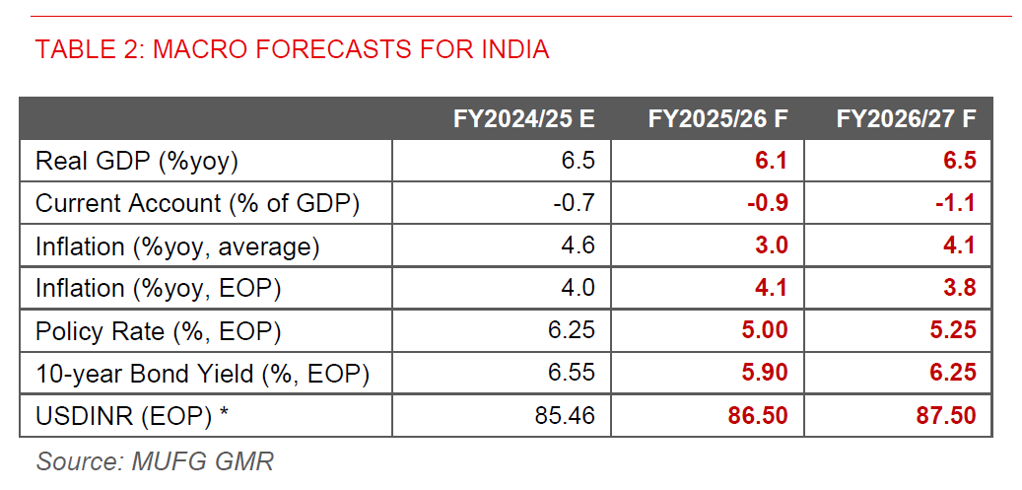
US tariffs on India could cut GDP growth by 0.3%, and weigh on the Indian Rupee
The most important development for India was the announcement by President Trump that India will receive a 25% tariff, together with an unspecified penalty for buying Russian energy and weapons. We have been assuming that India strikes a trade deal with the US with tariffs likely below 20%, and as such, the latest tariff announcement is a downside surprise relative to our previous forecast assumptions for USD/INR and India’s GDP growth and macro outlook.
We see these tariff developments as being an important negative for India and the Indian Rupee, even as we acknowledge mitigating factors such as the more domestic nature of India’s economy, and also continued tariff exemptions on the electronics and pharmaceutical sectors.
First, we note that US has been growing in importance for India’s goods export basket over time. The share of India’s exports going to the US has risen to 21% as 2025, up from 15% during the first Trump administration, and has been steadily increasing over the past decade. The increase has been driven in particular by the electronics and pharmaceutical sectors, but is not just confined to that (see Charts 3 and 4 below). The counterpart as well is that FDI and investment from US companies into India have been rising over time, albeit not just in the manufacturing sector. While India is trying to take steps to diversify its reliance on the US, in the near-term higher tariffs will weigh on India’s exports and FDI prospects.
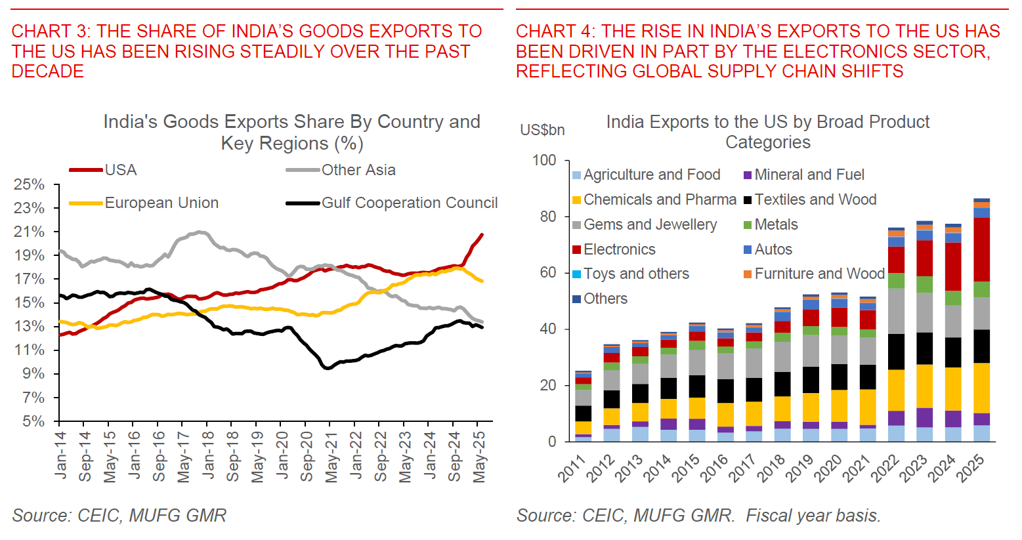
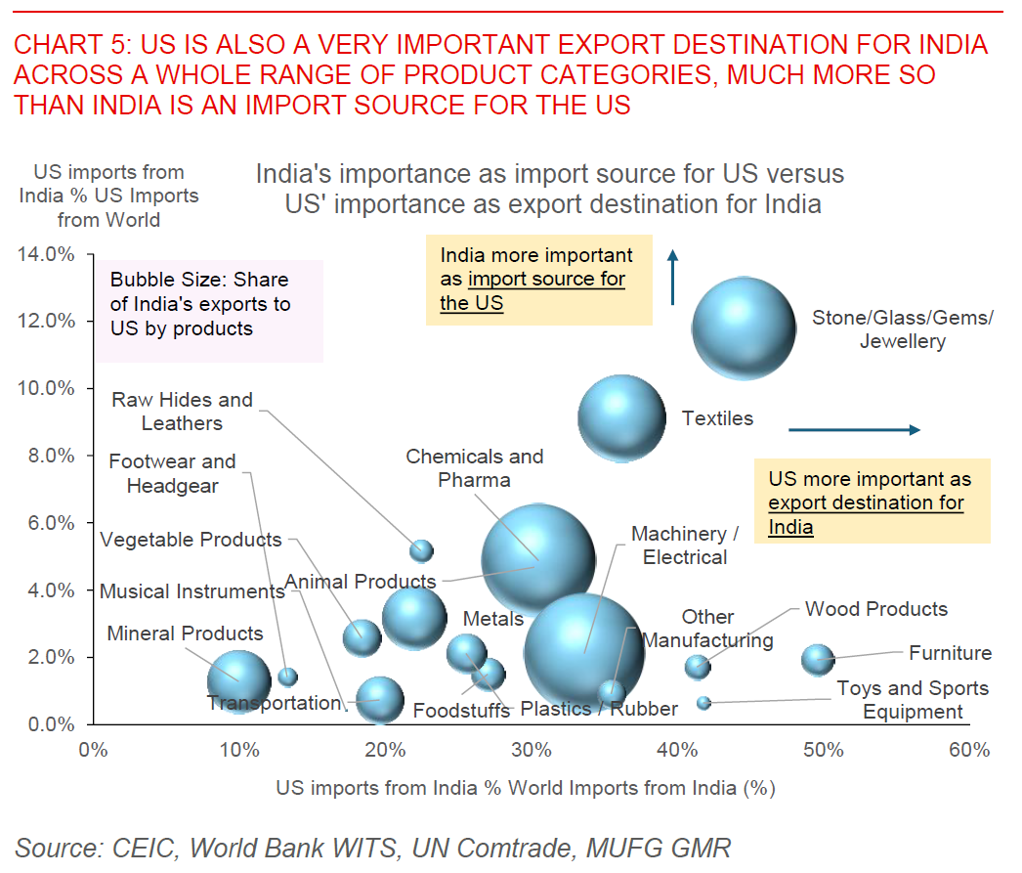
Secondly, the US is also much more important as an export destination for India across a whole range of products categories, more so than India is a source of import for the US. From a macro perspective, this implies that the US could more easily source for supplies from alternative import locations, but conversely it is much harder for India to diversify away from the US across different sectors. As such, India’s export markets may be hit harder perhaps much more than the headline reciprocal 25% tariff rate suggests.
From this perspective, we see sectors such as furniture, toys and sports equipment, wood products, and other manufacturing sectors as the most vulnerable to these tariff developments, given their heavy reliance on the US market for end-demand, and their small share in the US market as a source of import supply (see Chart 5 above). In addition, there is also a long tail of product categories ranging from shrimp production (80% reliance on the US market), manufacturing of straws (80% reliance), diary and honey (63%), cocoa (53%), carpets (56%), that are highly leveraged to the US market for exports, just to name a few examples.
Third and on a related point, many of India’s key export competitors across a range of sectors received lower tariff rates after the latest tariffs adjustments by the Trump administration (see Chart 2 above). These tariff changes include Vietnam (20% from 46%), Thailand (19% from 36%), Indonesia (19% from 32%), Bangladesh (20% from 35%), Cambodia (19% from 36%), among many others. India still enjoys a positive tariff differential against the likes of China and Switzerland after the latest changes, but for most others India’s tariffs of 25% are now higher.
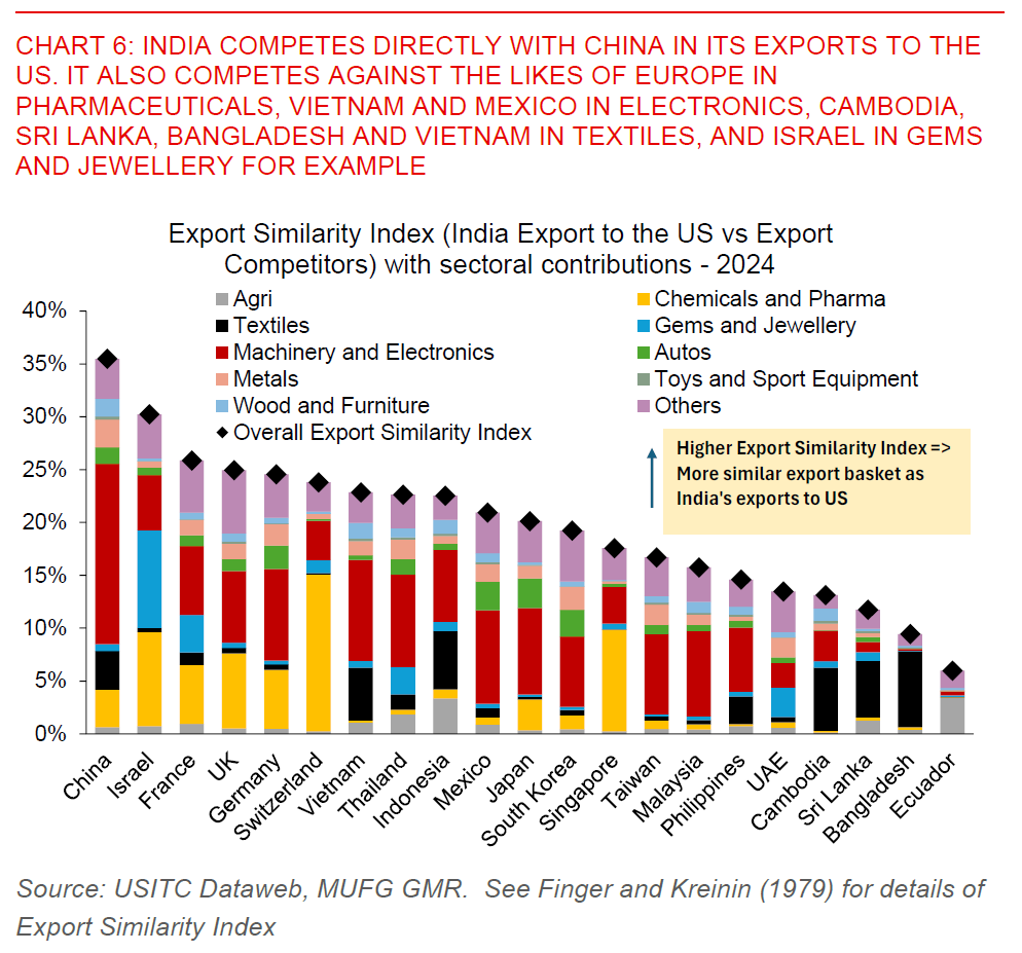
If these tariff differentials stick, India’s export competitiveness will likely be eroded over time. We can illustrate the key countries that India competes with by using the Export Similarity Index, which measures the extent to which India’s goods exports to the US overlaps with other trading partners (see Chart 6 above). We have also broken this down by key sectoral contributions to the index. Our analysis shows:
- India competes most head-on with China in its exports to the US from a headline perspective and across a wide range of products
- India also competes against the likes of EU and Switzerland in the chemicals and pharmaceuticals
- Vietnam, Thailand and Mexico are the biggest competitors in the electronics sector for India
- India competes most with Cambodia, Sri Lanka, Bangladesh and Vietnam in the textiles space
- In gems and jewellery, Israel and to a small extent Thailand and UAE compete head on with India in exports to the US.
Our best sense right now is that there will likely still be a trade deal between the US and India, given that there have already been a lot of good faith negotiations and so India is not starting out from a blank sheet of paper, with the US trade team scheduled to visit India for more talks in August with a view to complete talks by September/October.
Nonetheless, the key for India’s outlook as well is that the chance for India to get a much better rate relative to its many export competitors across a whole range of product categories as illustrated above is likely much lower.
Tariff exemptions on electronics and pharmaceuticals mitigates impact until sectoral tariffs come into play
What does help India are the existing tariff exemptions including on the electronics and pharmaceuticals sectors, at least until sectoral tariffs come into play when the Trump administration announces them.
We estimate that around 32% of India’s export basket to the US is currently exempt from tariffs, with the largest being the chemicals and pharmaceutical sector (17%), electronics sector (10%), together with a range of other sectors such as energy products (see Chart 7 below). Around 5% of India’s exports to the US are subject to sectoral tariffs such as in steel, aluminium, autos, and copper.
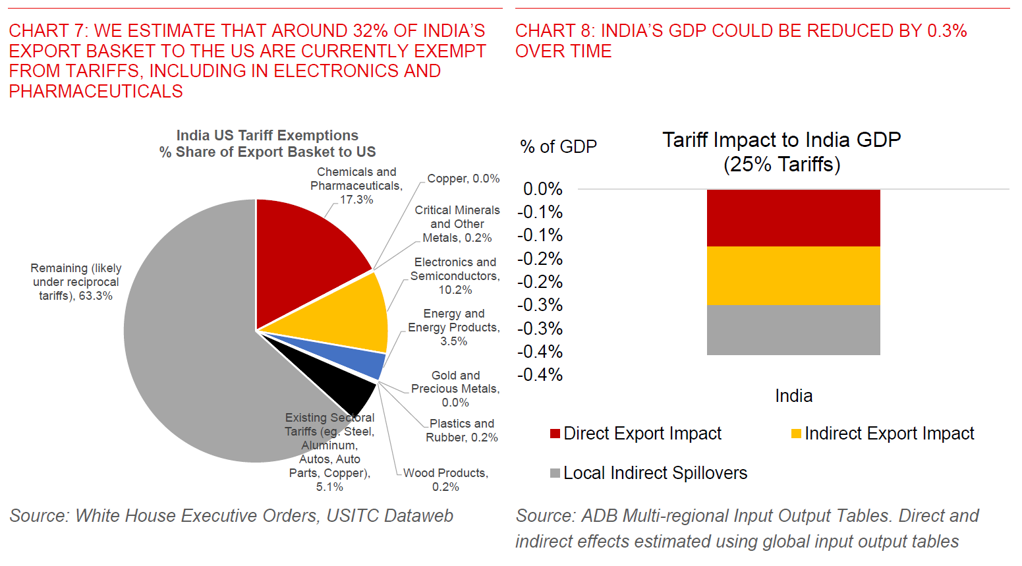
Taking all these into account, we estimate that India’s GDP could be reduced by around 0.3pp over time, and assuming that sectoral tariffs of 25% eventually fall on India’s electronics and pharmaceutical sectors. These effects could be larger if tariff differentials stick, and the US could conceivably substitute to India’s alternative supply sources across India’s export competitors as our analysis above shows. In our base case, we assume that India strikes a deal with the US and lowers its tariffs to 20% by October 2025, but importantly tariff uncertainty will remain a headwind in the meantime.
Possible secondary sanctions on India’s purchase of Russia oil a left tail risk for India and INR
The additional complication for India is the unspecified penalty for India for its purchases for Russia oil and military equipment as stated by Trump. The best estimates shows that India imports around 35% of its oil from Russia, although some of this also gets processed into petroleum products such as diesel and likely gets sent to other regions including Europe (see Chart 10 below). With the Russia oil discount now much lower at around US$1-2/bbl, petroleum product exports both in value and volume terms have also correspondingly fallen, although meaningful domestic demand needs in India implies continued imports of crude oil.
We estimate that if the Russia oil discount were to be removed completely, India’s oil import bill could directly rise by around US$2bn annually – not a huge impact by any means.
The indirect effects are however far more difficult to estimate and could be material for India. These include lower export margins for Indian refiners and by extension raising India’s trade deficit, and also the indirect effects of higher global oil prices if Trump’s secondary sanctions were to result in a material shift in global oil demand and supply dynamics. In addition, there could also be a more pronounced negative demand shock for India’s exporters if the US were to impose material additional tariffs on India through higher secondary sanctions.
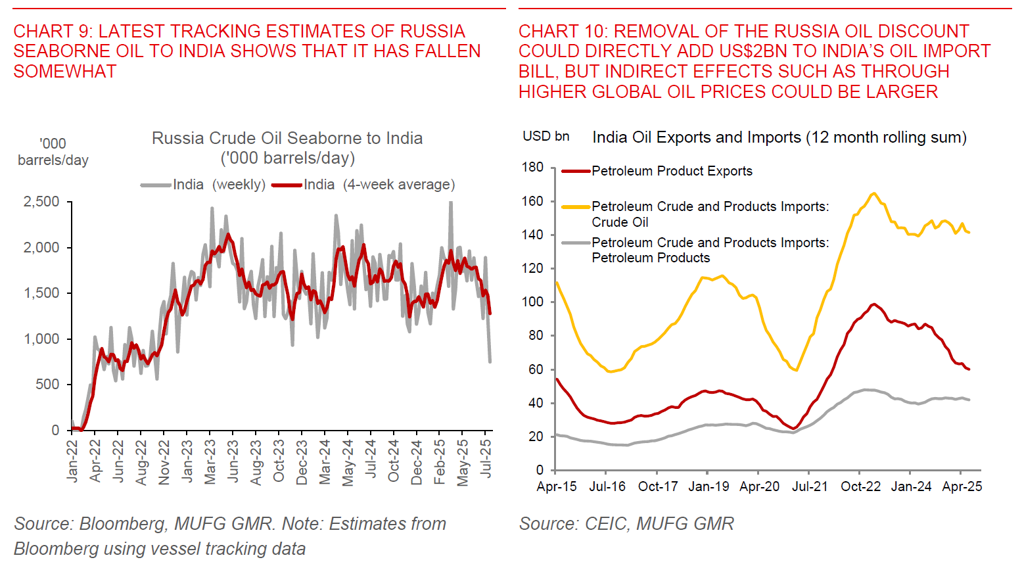
Our previous analysis of the impact of oil price shock although written for a different event (the Israel-Iran war) is still relevant in this context (see Asia: The impact of oil price shock on Asia FX). India’s current account deficit could rise above 2% of GDP if oil prices were to increase above US$90/bbl. There will be some passthrough to India’s inflation as well although some of it will be borne first by state-owned oil companies and perhaps subsequently also foregone revenues by first cutting oil excise duties.
Net-net, we see USD/INR potentially rising further perhaps above 88 levels if material threats on Russia secondary sanctions play out but stress this is not our base case. We do not assume either material Russia secondary sanctions and/or a sharp spike in oil prices, although we build in some gradual removal of the Russia oil discount in India’s trade deficit. Nonetheless, we think risks are balanced, given alternative scenarios of an eventual resolution in the Russia-Ukraine war, coupled with still ample global oil supplies.
RBI to cut rates two more times, bringing the repo rate to 5% from 5.50% currently. Low inflation and decent monsoon are key domestic positives
We also now forecast RBI to cut rates two more times, bringing the repo rate to 5.00% from 5.50% currently. This compares with our previous forecast of one more cut. We see these two cuts likely coming in the October and December meetings, and for the RBI to keep rates on hold thereafter till 2H2026. Our latest tracking of domestic economic activity shows that growth in India has softened over the past few months, led by weaker activity in urban consumption.
The good news from a domestic perspective is that inflation is likely to remain low and contained, while external stability indicators such as the current account deficit is likely to remain below 1% of GDP absent a sharp spike in global oil prices. This combined with a decent Southwest Monsoon, coupled with supportive monetary and fiscal policy are likely to remain key local drivers moving forward for India and INR.
